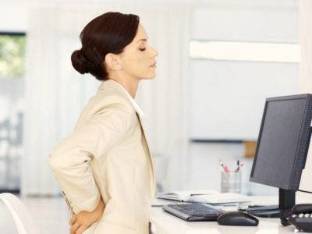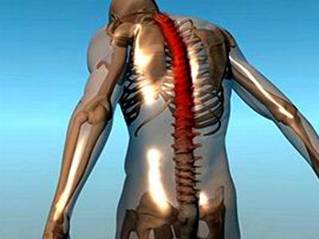If the person has back pain in the lumbar region, the causes can be different, up to the renal pathology. Most of the times this symptom driven disease-lumbar-sacral column. The lumbar spine is mobile, which makes it the most frequent cause of injuries in exactly this area.
By which develops the pain that is caused?

The back pain is only a symptom. The acute back pain, related to the violation of the work of the lumbar vertebrae and discs, called lumbago. Why the pain in the back, at the bottom, everyone should know. Highlight the following causes for this symptom:
- osteocondrose lumbar-sacral spine;
- hernia between the vertebrae;
- the disease Ankylosing;
- the displacement of the vertebrae;
- birth defects (the presence of the extension of the lumbar vertebra, by dividing the arms);
- the innate form of violation of the vertebrae;
- benign, malignant tumors and vascular;
- rheumatism;
- the inflammation of the back muscles (myositis);
- the inflammation of the sciatic nerve;
- fracture of the spinal column;
- spondylolisthesis;
- the osteomyelitis;
- fibrosite;
- osteoporosis;
- protrusion of the disk;
- narrowing of the spinal canal;
- osteoarthritis;
- renal disease (hydronephrosis, pyelonephritis, tumor).
The spine in the low back can hurt because of a simple muscle spasm. This is possible with the pronounced curve or perform the exercise. Back pain in the lumbar region is most common in people who lead a sedentary life and increase the severity. The individuals involved in sporting activities, this pathology occurs with much less frequency.
Pain sacral osteocondrose
If the constant pain in the loin behind, it can be a manifestation of degenerative disc disease, lumbar-sacral column. This disease, which are affected primarily the disks between the vertebrae. They antarctica, which leads to friction between them and decrease in the mobility of the disc. Highlight the following thus predisposing factors in the development of this disease are:
- spending hours in an uncomfortable posture;
- long bends;
- the lack of exercise, practice of physical exercises;
- weakness of the muscles and ligaments of the back;
- wearing backpacks 1 strap;
- availability for flat feet;
- hard physical work;
- the higher the static load;
- incorrect the organization of the workplace.
Back pains are the primary symptom of degenerative disc disease. If 1 degree of the disease the pain caused lack. With the development of a boss unit develops lumbago. Suddenly, the pain in the lower back. Some people feel it as a shock. It appears when a sudden change of posture or movement.
If the back pain in the lumbar region, the problem can be lumbodynia. The pain is chronic when osteocondrose. Their appearance does not depend on motor activities training human. The pain is uncomfortable. So, people have difficulty in flexing the body. In the position of a man lying in the back of the pain that is caused disappears or decreases.
When osteocondrose 3 degrees of evolution radicular syndrome. It manifests lumborum ischialgia. It is a pain that occurs in the lower limb to the toes. Many times, it combines with the violation of sensitivity. The discomfort in the lumbar region driven by the compression of nerves, blood vessels and muscle spasm spinal.
Signs of hernia

If worried about the low back pain, the causes can be found in the the intervertebral hernia. It is very common to the disease. When it the core of the disk vertebra displaced. Often in the midst of it, occurs the break of the fibrous rings. The incidence rate is 150 cases per 100 thousand. people. Are the following possible causes of the formation of the hernia:
- injury (injury, drop);
- osteocondrose lumbar-sacral of the department;
- the excess weight;
- the curvature of the spine;
- curves.
In the group of risk includes the drivers and employees, who work behind a computer. Pain in the hernia has the following characteristics:
- is the local;
- many times in thigh, buttocks and calf;
- it combines with other symptoms (numbness, tingling);
- is enhanced during physical exertion.
The manifestation of the starting point of the pain of the syndrome is determined by the amount of the hernia. If it is large, then it can develop sciatica. It manifests itself in the fact that. Strong is the pain in the form of lumbagoes.
The majority of patients with hernia develops pain type of low back pain. The additional symptoms of hernia applies to reduction of power, the limitation of the mobility of the lumbar spine, weakness in the legs. Sometimes interrupted urination.
The symptoms, when ankylosing spondylitis
When the back pain in the region of the sacrum and lumbar spine over a long period of time, one can suspect disease Ankylosing.
It is a chronic, systemic disease, in which the most frequently affected joints in the spinal column. The exact causes of the development of this disease is not installed. Highlight the following possible etiological factors:
- the inflammation of the organs of the urinary system;
- hypothermia;
- the injury of bones;
- the hereditary predisposition;
- the infection.
The disease Spondylitis occurs mainly in young individuals between the ages of 15 and 40 years of age. This pathology manifests itself joint and non-joint symptoms. The back pain and stiffness of the vertebral column are considered earlier, a symptom. The pain felt in the likely the sacral department. In the initial stages, it expresses weak. Their appearance is caused by the inflammation.
The pain is bilateral. Many people say that the pain that is caused more clearly expressed by one side. It lasts more than 3 months and does not pass. The disease develops very slowly. The pain bother these people, mainly in the morning time. Perhaps its appearance, after a long static load.
At noon, it decreases. Pain that is caused is enhanced in the state of rest and disappears during a job. In the phase of the heat pain occurs during the night and during the work. In the later stages of the evolution sciatica. Pain that is caused when the disease Ankylosing combines with the deterioration of the general well-being of a person, by restriction in chest, wheezing, omission of head, pain in the muscles and in the chest. Many times they are surprised with the eyes.
Kidney disease

If the back pain in the lumbar region, the reason can be the renal disease (hydronephrosis or pyelonephritis). The kidneys are retroperitoneal. When the inflammation (pielonefritee) low back pain is the most frequent complaint of patients. This disease is often the norovirus in children and young people. Pyelonephritis often develops in the context of kidney disease.
The disease has an infectivity nature. The brightest flows sharp pyelonephritis. It is characterized by pain in the lower back, nausea, increased body temperature, chills, weakness, sickness, frequent urination. Often appear swelling. The pain more often on one side, silent and steady. Irradiation it available in the area of the hypochondrium, the lower part of the belly and the belly button.
If there was no low back pain, the causes can be found in the hidronefrosee. It is a disease in which occurs the extent of renal calyx pelvis. Often this pathology develops in small children. The basis of the development of the hidronefrosea is the violation of the output of urine, incorrect operation of valves and obstruction of the urinary tract.
When the hidronefrosee appears sharp pain in the back. She is irradiating. It occurs on the side, a little above the pelvis. The pain paroxysmal, reminiscent of renal colic. Pain that is caused combines with the nausea, the vomiting, the advent of blood in the urine.
The demonstrations, when sciatica pain
If strongly hurts the vertebral column in the lumbar region, the cause may be an inflammation of the sciatic nerve. This state is called sciatica pain. In the at-risk group is composed by the person to an advanced age. Sciatica (sciatica), often develops in the midst of the intervertebral hernia, infectious diseases (influenza, malaria, tuberculosis), osteoarthritis, drunkenness. Many times, sciatica can occur in pregnant patients.
Pain when sciatica pain has the following characteristics:
- acute (dagger);
- permeates;
- intense;
- burning or shooting;
- initially appears in the lower part of the back, and then down (the descending nature);
- applies to the buttock, thigh and calf;
- concerned constantly in the form of crises;
- has the same force;
- more of a side.
The pain is accompanied by tingling, numbness and change of mobility disorders. The other symptoms of sciatica refers to muscle atrophy, the violation of the sweating, the dryness and the thinning of the skin.
The plan of examination of patients
Not everyone knows what to do, if the back pain in the lumbar region. You should consult a doctor and take the exam. May be required the following studies:
- computed tomography;
- x-ray lumbar-sacral spine;
- Ultrasonography of the kidneys;
- magnetic resonance imaging;
- electroneuromyography;
- Doppler of the blood vessels;
- general and biochemical analysis of blood;
- the analysis of the urine;
- cystourethrography.
Necessarily is performed the inspection and palpation of the lumbar region and the spine. Requires the consultation of a neurologist or vertebrologist. On examination, the doctor evaluates the mobility of the spine, reflexes, muscle strength, the volume of movements in the limbs. Almost always, the cause of low back pain are diseases of the vertebral column. It is easy to identify in the photograph.
Medical therapies

If a strong pain in the back, the treatment must be directed to the cause of the pain. Apply the following treatment methods:
- system drug therapy;
- the use of local analgesics in the form of gels and ointments;
- physical therapy;
- the chiropractic;
- acupuncture;
- the lock;
- surgical treatment;
- Therapy exercise.
Such patients should do the gym and to comply with protein diet. Run the exercises should have a high amplitude. If back pain is a symptom of pyelonephritis, it is necessary to respect the rest, take analgesics and antibiotics. When the chronic inflammation, in addition, are assigned to a diuretic. Antibiotics, preferably fluoroquinolones and penicillin.
In addition, you are assigned immunomodulators and vitamins. In the case of development the hidronefrosea it may be necessary to surgical treatment. Pain at the bottom of the sciatica apply analgesics (Analgin), a combination of tools, NSAIDS. In severe cases need novocain the lock. The scheme of treatment include massage, gym, such as acupuncture.
To eliminate the pain can be performed distraction therapy. Applies an ointment with bee or snake venom. When the hernia shows NSAIDS, traction of the spinal column, massage, and therapeutic exercise. In severe cases, surgery is required. When the pain in the bottom of the stems of the treatment involves immobilization of the spine, the application of analgesics and intramuscular administration of anesthetics. In addition, you are assigned group B vitamins (Combilipen).
Effective and physical therapy. When the detection of the degenerative disc disease is shown therapeutic exercise, massage, receiving analgesic therapy for exercise. Necessarily are assigned chondroprotectors. So ill need to move more and less time standing or sitting. The scheme of treatment include manual therapy and the lock. Therefore, the appearance of pain in the lower back is the reason for treatment in the hospital.

























